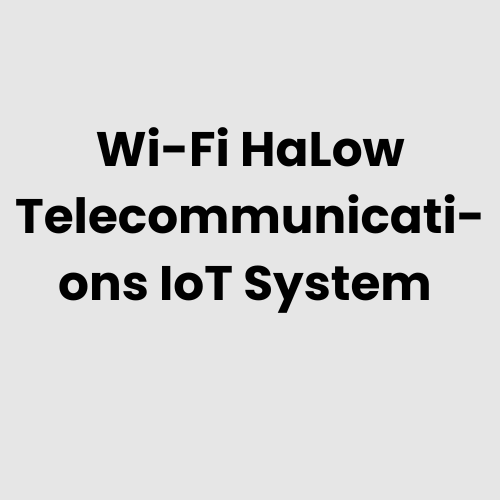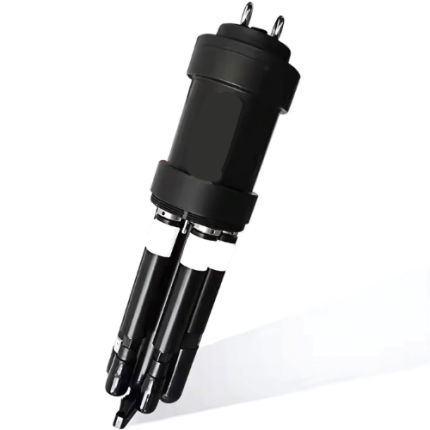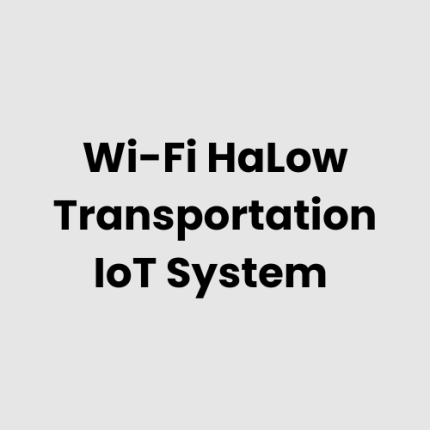Description
Technical Architecture of Wi-Fi HaLow Enabled Telecommunications IoT System
The Wi-Fi HaLow Enabled Telecommunications IoT System leverages advanced IoT technology for high-performance, low-power, and long-range connectivity across telecommunications infrastructure. The system integrates multiple layers of hardware and software to enable seamless communication and monitoring of telecommunication equipment, enhancing operational efficiency.
- IoT Sensors: Critical sensors collect real-time data from telecommunications equipment such as routers, signal amplifiers, and towers.
- Wi-Fi HaLow Network: The system utilizes Wi-Fi HaLow (IEEE 802.11ah) for wide-area, low-power connectivity that supports long-distance data transmission in telecom environments.
- Edge Computing Devices: These devices handle local data aggregation and preprocessing, reducing latency and optimizing network traffic before sending data to central servers or cloud platforms.
- Centralized Server: A centralized server, often hosted locally or in the cloud, processes the collected data and generates actionable insights for network optimization and maintenance.
- Cloud Integration: For extended data storage and advanced analytics, the system integrates with cloud platforms, facilitating long-term data management and performance monitoring.
Hardware List for Wi-Fi HaLow Enabled Telecommunications IoT System
- IoT Sensors: Environmental sensors, signal strength monitors, temperature sensors, humidity sensors, and vibration sensors.
- Wi-Fi HaLow Access Points: Access points designed to support long-range, low-power communication across the telecommunications network.
- Edge Computing Gateways: Devices to collect, preprocess, and securely transmit data from remote locations to centralized servers or the cloud.
- Central Server: For data aggregation, storage, and real-time analytics, either located on-premise or in a data center.
- Power Supply Systems: Uninterrupted power supplies (UPS) to ensure continuous operation of network equipment, even during power interruptions.
- Antennas: Directional and omnidirectional antennas for Wi-Fi HaLow communication, ensuring reliable signal coverage across large distances.
- Mobile Devices: Tablets, smartphones, or specialized monitoring devices for field personnel to interact with the system and remotely monitor telecommunications infrastructure.
Physical Placement Considerations of Hardware
- IoT Sensors: Sensors should be placed at key locations such as on telecommunications towers, routers, signal amplifiers, and other critical network components to gather real-time data on environmental factors, signal strength, and system health.
- Wi-Fi HaLow Access Points: Access points must be strategically located throughout the telecommunication network to ensure full coverage over a wide area. These access points should be placed to maximize signal strength and minimize interference.
- Edge Gateways: Positioned at key points to aggregate data from multiple sensors and transmit it efficiently to central servers. These gateways should be placed in secure areas with reliable power sources to ensure continuous operation.
- Central Server: Located in a controlled, secure facility with backup power and cooling systems to maintain the performance of data processing and storage operations.
- Power Supply Systems: UPS units should be deployed near critical networking equipment, ensuring that communication continues even during power disruptions.
Hardware Architecture of Wi-Fi HaLow Enabled Telecommunications IoT System
The hardware architecture of the Wi-Fi HaLow Enabled Telecommunications IoT System is built for high scalability, reliability, and security:
- Sensor Layer: A variety of sensors are placed throughout the telecommunications infrastructure, continuously monitoring performance metrics such as signal strength, power consumption, and environmental conditions.
- Communication Layer: The Wi-Fi HaLow network enables secure, long-range communication between devices, offering high throughput with minimal power consumption, especially in remote areas.
- Edge Computing Layer: Edge gateways process data locally, reducing the load on the central server and ensuring that only relevant, pre-processed data is transmitted, improving efficiency.
- Server Layer: Centralized servers handle data aggregation, analysis, and decision-making, offering a holistic view of the network’s performance and health.
- Cloud Layer: For data storage, analytics, and remote access, the system integrates seamlessly with cloud platforms that offer scalable storage solutions and advanced analytics capabilities.
Deployment Considerations of Wi-Fi HaLow Enabled Telecommunications IoT System
- Site Selection: It is essential to choose optimal locations for IoT sensors and Wi-Fi HaLow access points to ensure full coverage, especially in large, dispersed telecommunications facilities or remote areas.
- Network Integration: The system must be integrated with existing telecommunications infrastructure to ensure smooth operation and prevent disruptions during deployment.
- Security: Given the critical nature of telecommunications networks, all data communications, from edge devices to cloud platforms, should be encrypted to prevent unauthorized access.
- Scalability: As the telecommunications network expands, the IoT system should be scalable to accommodate new sensors and devices, allowing for easy integration of additional hardware without disrupting the network’s performance.
- Maintenance and Support: Regular maintenance schedules should be established to ensure all hardware components, especially sensors and gateways, are functioning optimally. GAO Tek provides expert support remotely or onsite to address any issues that arise.
List of Relevant Industry Standards and Regulations
- IEEE 802.11ah (Wi-Fi HaLow)
- ISO/IEC 27001 (Information Security Management)
- ITU-T G.703 (Physical Layer Specifications for Digital Transmission)
- ETSI EN 301 893 (Regulatory Standards for Wi-Fi)
- ISO 9001:2015 (Quality Management Systems)
- IEC 61508 (Functional Safety)
- NIST SP 800-53 (Security and Privacy Controls for Federal Information Systems)
- ANSI/TIA-568 (Structured Cabling Standards)
- ITU-T Y.2022 (Telecommunication Networks – IoT Standards)
Local Server Version of Wi-Fi HaLow Enabled Telecommunications IoT System
The Wi-Fi HaLow Enabled Telecommunications IoT System offers a local server version, which provides the following benefits:
- Local Data Processing: Critical data can be processed on-site, allowing for faster decision-making and reducing dependency on external cloud services.
- Reliability: The local server ensures that the system can continue to operate even if cloud connectivity is temporarily lost, providing high availability for mission-critical operations.
- Security: Sensitive data can be kept within the local infrastructure, offering additional layers of protection against potential data breaches.
GAO Tek Inc. can help tailor a local server solution for your telecommunications IoT deployment, ensuring seamless integration and optimal performance.
Cloud Integration and Data Management
Cloud integration is a key feature of the Wi-Fi HaLow Enabled Telecommunications IoT System, enabling efficient data storage, analysis, and management. Key aspects of cloud integration include:
- Real-time Data Aggregation: Data from remote sensors is collected and sent to the cloud for further processing and storage.
- Advanced Analytics: Cloud platforms provide powerful analytics tools to help telecommunications companies analyze network performance and predict potential failures or inefficiencies.
- Remote Access: Authorized personnel can access the system remotely through cloud-based interfaces, allowing for continuous monitoring and control from anywhere in the world.
- Scalable Data Storage: Cloud platforms offer scalable storage solutions, making it easy to expand as more devices are added to the network.
- Security and Compliance: Cloud services follow industry-leading security protocols to protect sensitive data and ensure compliance with regulations.
GAO Tek Inc. offers robust cloud integration solutions that seamlessly connect your telecommunications IoT system to the cloud, providing enhanced monitoring, analytics, and data management capabilities.
GAO Case Studies of Telecommunications IoT
USA Case Studies
- Houston, Texas: A major oil and gas company deployed IoT solutions to monitor pipeline conditions in real time. The system helped identify potential leakages and pressure anomalies, reducing operational downtime and improving safety. Learn more about pipeline monitoring technologies.
- Midland, Texas: An energy firm implemented IoT-enabled asset tracking for their drilling equipment. By leveraging real-time location data, the company streamlined logistics and optimized inventory management, improving efficiency in remote operations. Explore advancements in asset tracking.
- Denver, Colorado: A gas processing plant adopted IoT solutions to monitor environmental conditions, ensuring compliance with local regulations. The technology enabled proactive detection of hazardous emissions and improved sustainability efforts. Discover environmental monitoring technologies.
- San Antonio, Texas: A telecom provider integrated IoT-based network management systems to enhance operational visibility across remote infrastructure. The system enabled the detection of performance issues and minimized system downtimes, boosting network reliability. Explore network monitoring solutions.
- Dallas, Texas: A large-scale data center integrated IoT-based power and cooling systems. By continuously monitoring energy consumption, the facility reduced operational costs and ensured optimal performance, contributing to its sustainability goals. Learn about data center management.
- Los Angeles, California: A logistics firm implemented IoT-enabled vehicle tracking to optimize fleet management. By analyzing real-time data on vehicle locations and statuses, the firm improved delivery times and customer satisfaction. Learn more about fleet management.
- Chicago, Illinois: A water utility service adopted IoT-based sensors for real-time water quality monitoring. The solution helped the service company enhance compliance with environmental standards and improve water treatment processes. Explore water quality monitoring.
- Miami, Florida: A renewable energy provider used IoT-based systems to monitor solar panel performance. This enabled real-time performance tracking and maintenance scheduling, increasing the overall energy efficiency of the solar farm. Discover solar energy IoT solutions.
- Phoenix, Arizona: A manufacturing plant leveraged IoT-based asset management technology to optimize inventory and reduce maintenance costs. Sensors provided real-time insights into equipment status, enabling predictive maintenance and improving overall productivity. Learn about industrial asset management.
- New York, New York: A smart city initiative in New York implemented IoT-based streetlight monitoring systems. The solution allowed for real-time adjustments to streetlight brightness, improving energy efficiency and reducing operational costs. Discover smart city solutions.
- Seattle, Washington: A port authority integrated IoT-based cargo tracking systems. By utilizing sensors to monitor the location and condition of containers, the authority improved logistics efficiency and cargo handling times. Learn about cargo tracking systems.
- Atlanta, Georgia: A national telecom provider implemented IoT-based environmental monitoring solutions for their base stations. The technology provided real-time data on temperature, humidity, and airflow, helping prevent equipment malfunctions. Explore environmental monitoring.
- Boston, Massachusetts: A research institute deployed IoT solutions for the monitoring of air quality. By utilizing real-time data, they were able to track pollution levels and study the effects of environmental changes on public health. Discover IoT for environmental monitoring.
- Salt Lake City, Utah: A mining operation used IoT-based equipment monitoring systems. The solution tracked machinery performance and detected anomalies, helping reduce maintenance costs and increase operational uptime. Explore IoT in mining.
- Orlando, Florida: A tourist attraction implemented IoT-based visitor tracking systems. By using real-time data, the park improved crowd management, optimized operational efficiency, and enhanced the guest experience. Learn about visitor tracking systems.
Canada Case Studies
- Toronto, Ontario: A public transportation system deployed IoT-based vehicle tracking and scheduling technology. This improved the accuracy of arrival times, reduced operational inefficiencies, and enhanced the rider’s experience. Discover transportation IoT solutions.
- Vancouver, British Columbia: A utility provider integrated IoT-based smart grid solution. The technology allowed real-time monitoring of power consumption, enabling faster response times during outages and contributing to better resource management. Learn more about smart grid solutions.
These case studies highlight how GAO Tek’s advanced IoT technologies are helping companies across the USA and Canada streamline operations, enhance safety, and improve overall efficiency. GAO Tek’s solutions are tailored for various industries, including energy, manufacturing, logistics, telecommunications, and environmental monitoring. Let us help you unlock the potential of IoT for your business. Contact us to learn more.
Navigation menu for Wi-Fi HaLow
- Wi-Fi HaLow Gateways/Routers
- Wi-Fi HaLow End Devices
- Wi-Fi Halow – Cloud, Server, PC & Mobile Systems
- Wi-Fi HaLow Accessories
Navigation Menu for IoT
- LORAWAN
- Wi-Fi HaLow
- Z-WAVE
- BLE & RFID
- NB-IOT
- CELLULAR IOT
- GPS IOT
- IOT SENSORS
- EDGE COMPUTING
- IOT SYSTEMS
Our products are in stock and can be shipped anywhere in the continental U.S. or Canada from our local warehouse. For any further information, please fill out this form or email us.
We are looking for partners. For more information on partnering with GAO, please visit Partner with GAO Tek Inc. It lists various ways to partner with GAO, such as OEM Partnerships, Technology Integration, Distribution and Reselling Opportunities, Presenting at the Leading Event TekSummit, Joint R&D Projects, Training and Consulting Services, Industry-Specific Collaborations, Research and Academic Partnerships.



